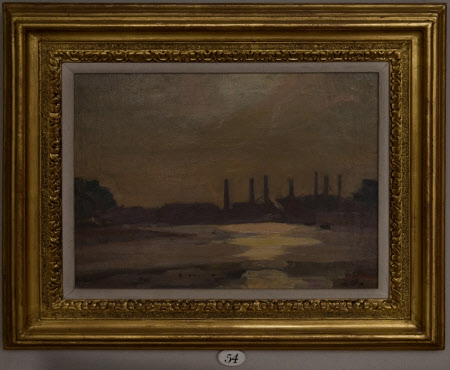Thames at Chelsea
Harold Gilman (1876 - 1919)
Category
Art / Oil paintings
Date
1899 - 1901
Materials
Oil on canvas
Measurements
270 x 360 mm
Order this imageCollection
Mottisfont, Hampshire
NT 769764
Caption
Gilman was a founder of the Camden Town Group, so-called because they gathered at the studio of Walter Sickert in Camden. This group of artists was active from 1911 to around 1913. Gilman had met Sickert in 1907 and was later influenced by the first Post-Impressionist exhibition at the Grafton Galleries in 1910. He soon outgrew Sickert’s stylistic influence, becoming more reliant on French artists such as Van Gogh, Gauguin and Signac, many of which featured vivid colour, thick textured paint and a strong sense of patterning and design. Gilman later branded himself a ‘Neo-Realist’, and exhibited under that label in 1914. James McNeill Whistler was another major influence. This study in silvery greys of a moonlit Thames scene recalls Whistler’s ‘nocturnes’, seen as daring in their day.
Summary
Oil painting on canvas, Thames at Chelsea by Harold John Wilde Gilman (Road 1876 – London 1919), 1899 - 1901. Part of the Derek Hill Collection.
Full description
Oil painting on canvas, Thames at Chelsea by Harold John Wilde Gilman (Road 1876 – London 1919), 1899 - 1901. Part of the Derek Hill Collection. Gilman was a founder member of the London Group, and its first President (1914-18). Walter Sickert had introduced him to the daring new work produced by the French Post-Impressionists, many of which featured vivid colour, thick textured paint and a strong sense of patterning and design. James McNeill Whistler was another major influence on Gilman. This study in silvery greys of a moonlit Thames scene recalls Whistler’s ‘nocturnes’, seen as daring in their day. Gilman is clearly interested in the play of light on water here, but this is not an atmospheric sketch dashed off on the spot. He used a grid to ensure that his compositions were constructed with exacting precision. Each chimney has been carefully positioned with the overall design in mind. Gilman’s life and career were sadly cut short by the influenza epidemic of 1919.
Provenance
Presented by Derek Hill (1916 - 2000) through The National Art Collections Fund (Art Fund), 1996
Credit line
Mottisfont Abbey,The Derek Hill Collection (presented to the National Trust through the National Art-Collections Fund in 1996)
Makers and roles
Harold Gilman (1876 - 1919), publisher
